Oscillations | Physics - Book Back Numerical Problems | 11th Physics : UNIT 10 : Oscillations
Chapter: 11th Physics : UNIT 10 : Oscillations
Book Back Numerical Problems
Oscillations (Physics)
Numerical Problems
1. Consider the Earth as a homogeneous sphere of radius R and a straight hole is bored in it through its centre. Show that a particle dropped into the hole will execute a simple harmonic motion such that its time period is

Solution
Earth is assumed to be a homogeneous sphere.
Its centre is at O and Radius = R
The hole is bored straight through the centre along its diameter. The acceleration due to gravity at the surface of the earth = g
Mass of the body dropped inside the hole = m
After time t, the depth it reached (inside the earth) = d
The value of ‘g’ decreases with deportation.
So acceleration due to gravity at deportation = ‘g'
i.e.,g' = g(l -d//R) = g( (R-d) / R) ...(1)
Let y be the distance from the centre of the earth
Then y = Radius - distance = R - d
Substitute y in (1)
g' = g y/R
Now, force on the body of mass m due to this new acceleration g' will be
F = mg' = mgy /R
and this force is directed towards the mean position O.
The body dropped in the hole will execute S.H.M Spring factor k = mg/Radius

2. Calculate the time period of the oscillation of a particle of mass m moving in the potential defined as
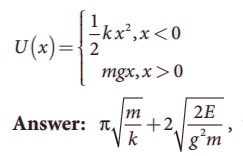
where E is the total energy of the particle.
Solution
Length of simple pendulum l = 0.9 m
Inclined plane with the horizontal plane α = 45°
Time period of oscillation of simple pendulum T = ?
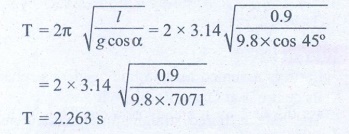
3. Consider a simple pendulum of length l = 0.9 m which is properly placed on a trolley rolling down on a inclined plane which is at θ = 45° with the horizontal. Assuming that the inclined plane is frictionless, calculate the time period of oscillation of the simple pendulum.
Answer: 0.86 s
4. A piece of wood of mass m is floating erect in a liquid whose density is ρ. If it is slightly pressed down and released, then executes simple harmonic motion. Show that its time period of oscillation is 
Solution:
Spring factor of liquid = Aρg
Inertra factor of wood piece = m
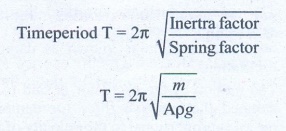
5. Consider two simple harmonic motion along x and y-axis having same frequencies but different amplitudes as x = A sin (ωt + φ) (along x axis) and y = B sin ωt (along y axis). Then show that

and also discuss the special cases when
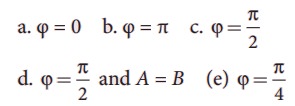
Note: when a particle is subjected to two simple harmonic motion at right angle to each other the particle may move along different paths. Such paths are called Lissajous figures.
Answer :
a. y=B/A x equation is a straight line passing through origin with positive slope.
b. y= - B/A x equation is a straight line passing through origin with negative slope.
c.  equation is an ellipse whose center is origin.
equation is an ellipse whose center is origin.
d. x2+y2 = A2, equation is a circle whose center is origin .
e.  equation is an ellipse (oblique ellipse which means tilted ellipse)
equation is an ellipse (oblique ellipse which means tilted ellipse)
6. Show that for a particle executing simple harmonic motion
a. the average value of kinetic energy is equal to the average value of potential energy.
b. average potential energy = average kinetic energy = ½ (total energy)
Hint : average kinetic energy = <kinetic energy > = 1/T ∫0T(Kinetic energy) and average Potential energy = <Potential energy> =1/T ∫0T(Potential energy)
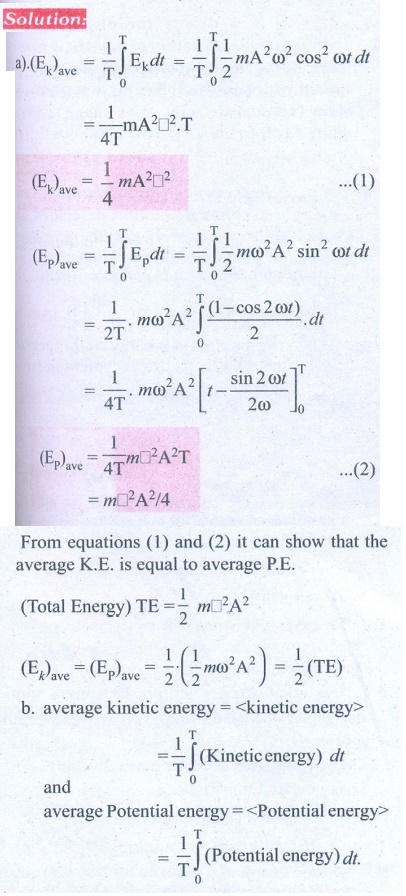
7. Compute the time period for the following system if the block of mass m is slightly displaced vertically down from its equilibrium position and then released. Assume that the pulley is light and smooth, strings and springs are light.
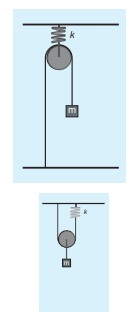
Hint and answer:
Case(a)
Pulley is fixed rigidly here. When the mass displace by y and the spring will also stretch by y. Therefore, F = T = ky

Case(b)
Mass displace by y, pulley also displaces by y. T = 4ky.

Related Topics